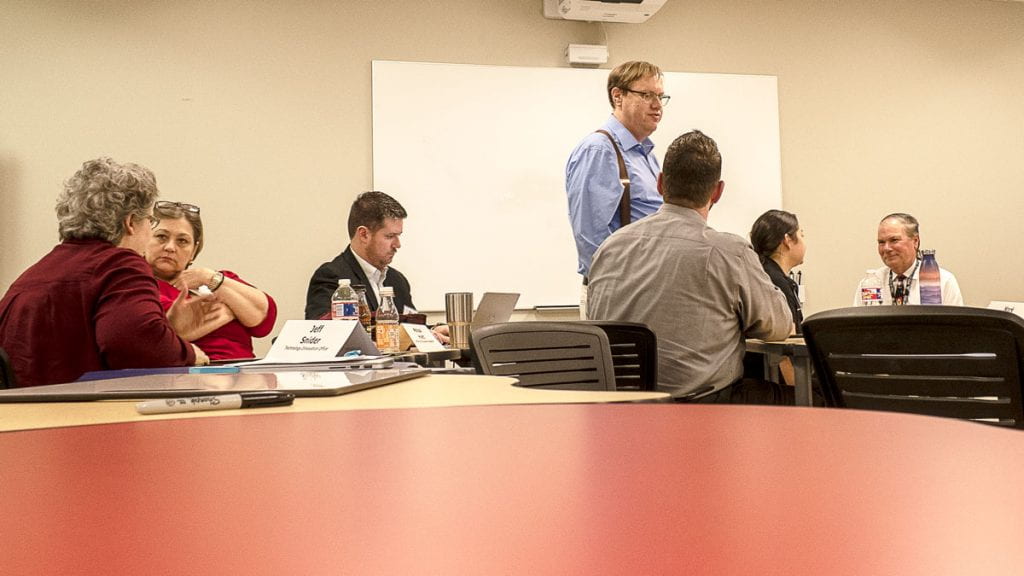On Feb. 14, 2019, staff in the Technology Innovation Office met with stakeholders for an initial brainstorming session around attendance taking at Texas State. Our goal was to generate ideas and gather feedback around the following problem statement.
The university needs a unified, low cost, accurate and secure system to gather classroom attendance and make the data available to relevant stakeholders in a timely manner.
The session generated numerous ideas that were then categorized and voted on. The stakeholders also added valuable information by contributing concerns and considerations that should be addressed for any potential solutions.
Engagement
Stakeholder engagement was divided in two phases:
- A two-hour face-to-face ideation session that presented attendees with the problem statement and offered opportunities to brainstorm ideas, discuss ideas, share concerns and vote on ideas, or idea-groups. Seventeen people attended the session. The group consisted of faculty representatives, the Office of the University Registrar, IT Assistance Center (ITAC), Technology Resources, Division of Information Technology (DOIT), and the Technology Innovation Office (TIO).
- A five-day period for additional votes, comments, and conversation via Yammer – the online social media tool within Office 365
Session Recap
| Idea | Votes |
| Code Based – A random generated code (QR or other) that requires student interaction to verify attendance in the room. | 13 |
| Mobile device application that leverages geo location | 12 |
| Mobile device with Wi-Fi location verification | 9 |
| Mobile Bluetooth location enabled check-in | 6 |
| Quizzes and polls | 3 |
| Card scanners – updated to include camera facial capture | 3 |
| Biometrics – facial recognition or fingerprint scanning | 0 |
| Clickers | 0 |
Analysis
During the session the following concerns were identified as important for the successful implementation of a new solution. A new system:
- Should need minimal instructor intervention
- Should reduce time needed to take attendance
- Should reduce the ability to “cheat” as much as possible
- Should be non-intrusive
- Should be user friendly
- Needs to integrate with Banner and gradebook tool
- Alternatives need to be provided for students without devices, if the attendance method is personal device dependent
- Students should have easy access to their own attendance records
- Easy to create attendance reports based on the role of the consumer of the data
- Records should be easily audited
- Attendance needs to be quickly available for verification
- Mechanism to take into account those that arrive late or leave early
- Meets information security standards
As a result, TIO will focus efforts on solutions that have the potential to address those concerns.
Potential Solutions
Based on the original goal and information gather during the initial brainstorming and feedback, TIO will move forward with the following ideas
- Wi-Fi location-based verification and check-in
- Bluetooth location-based verification and check-in
The final solution may be an application that leverages either a Bluetooth enabled device or Wi-Fi technology to automatically capture attendance.
The final solution should provide:
- A student opt-in option that automates access for the length of the course
- Logging capability to verify device is located within a defined area
- Automatic update to the official attendance record within banner
- Automatic update to LMS attendance or gradebook tool
- Instructor ability to change data if automatically entered into each system
- Alternative option should a student not have a physical device
- Alternative option should a student not have a Bluetooth or Wi-Fi enabled device
- Alternative options to address student accessibility
Outcomes
The goal of the meeting was to gain additional insight into the viability of potential solutions and identify assumptions that will need to be considered during the design, prototyping, and testing phases. This was the first time the Technology Innovation Office tested its collaborative, inclusive ideation process, to elicit stakeholder solutions for a stated problem. The session yielded very positive results, setting up the stage for development of the proof of concept. Stayed tuned for a follow-up story on the outcomes and results of the process that followed, where representatives from the following teams gathered to refine the technical implementation of the proposed solutions:
- Network Operations (Wi-Fi and data connection)
- Mobile/Web Systems (mobile app development and LMS integration)
- Learning Spaces (classroom technology and equipment)
- Enterprise Systems (programming and application support of management systems)
- TIO (project lead)
Dr. Carlos Solís is associate vice president for the Technology Innovation Office.
This report project component was completed by the Technology Innovation Office, including Laura Trial [Technology Resources]



